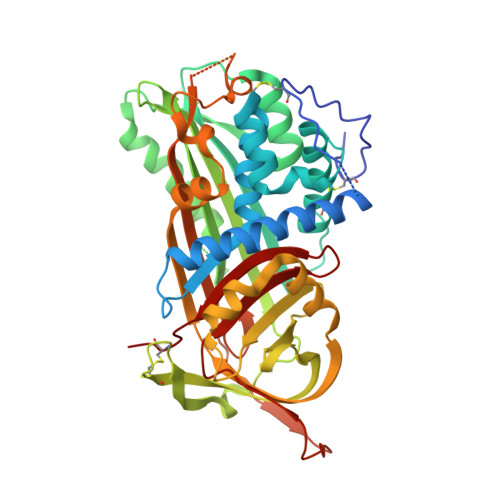Type II antithrombin deficiency caused by a large in-frame insertion: structural, functional and pathological relevance.
Martinez-Martinez, I., Johnson, D.J., Yamasaki, M., Navarro-Fernandez, J., Ordonez, A., Vicente, V., Huntington, J.A., Corral, J.(2012) J Thromb Haemost 10: 1859-1866
- PubMed: 22758787
- DOI: https://doi.org/10.1111/j.1538-7836.2012.04839.x
- Primary Citation of Related Structures:
4EB1 - PubMed Abstract:
The metastable native conformation of serpins is required for their protease inhibition mechanism, but also renders them vulnerable to missense mutations that promote protein misfolding with pathological consequences. To characterize the first antithrombin deficiency caused by a large in-frame insertion. Functional, biochemical and molecular analysis of the proband and relatives was performed. Recombinant antithrombin was expressed in HEK-EBNA cells. Plasma and recombinant antithrombins were purified and sequenced by Edman degradation. The stability was evaluated by calorimetry. Reactive centre loop (RCL) exposure was determined by thrombin cleavage. Mutant antithrombin was crystallized as a dimer with latent plasma antithrombin. The patient, with a spontaneous pulmonary embolism, belongs to a family with significant thrombotic history. We identified a complex heterozygous in-frame insertion of 24 bp in SERPINC1, affecting strand 3 of β-sheet A, a region highly conserved in serpins. Surprisingly, the insertion resulted in a type II antithrombin deficiency with heparin binding defect. The mutant antithrombin, with a molecular weight of 59 kDa, had a proteolytic cleavage at W49 but maintained the N-terminal disulphide bonds, and was conformationally sensitive. The variant was non-inhibitory. Analysis of the crystal structure of the hyperstable recombinant protein showed that the inserted sequence annealed into β-sheet A as the fourth strand, and maintained a native RCL. This is the first case of a large in frame-insertion that allows correct folding, glycosylation, and secretion of a serpin, resulting in a conformationally sensitive non-inhibitory variant, which acquires a hyperstable conformation with a native RCL.
Organizational Affiliation:
Centro Regional de Hemodonación, University of Murcia, Regional Campus of International Excellence Campus Mare Nostrum, Murcia, Spain.

















